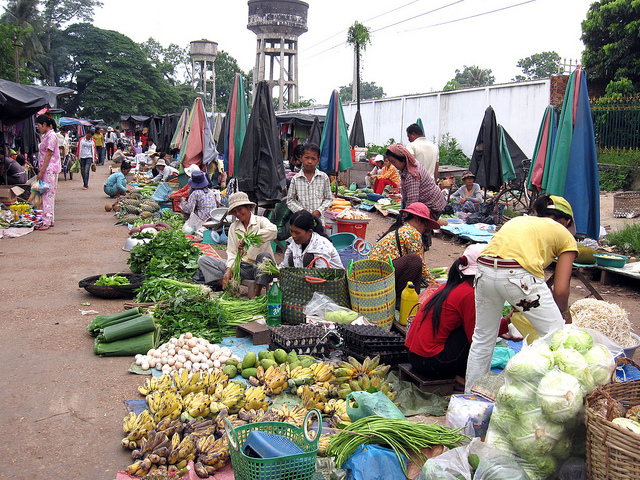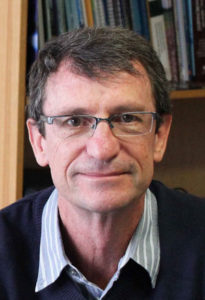

Opinion: Moving towards a circular economy in Asia: Connecting the city with the farm
March 22, 2018
By Andrew Noble
Over the past two decades the rate of economic growth in the Asia Pacific region has been one of the highest globally and has lifted over half a billion people out of poverty (ADB, 2016). However, this dramatic socio-economic success was achieved at great environmental cost due to unsustainable, and often inequitable, growth patterns. Rapid urbanization and industrialization has led to increasing waste and emissions, resulting in degradation of the region’s natural capital.

A key driver of this degradation has been urbanization. The region stands out from the rest of the globe in terms of absolute growth of urban population as well as number of densely populated megacities. Between 2010 and 2050, Asia’s urban population is anticipated to double in size to 3.2 billion—equivalent to an additional 100,000 new urban residents each day. By 2050, two-thirds of Asia’s population will be urban (ADB 2016). This has critical implications for the health and wellbeing for a significant proportion of the population. Managing this transformation will require a coordinated and integrated approach.
Interventions to increase urban resource efficiency and adopt circular economic approaches in Asian cities are being promoted by governments with the intention of creating social and economic opportunities whilst reducing adverse environmental impacts. A circular economy further promotes highly efficient resource use via life-cycle thinking for every resource and innovative practices to identify productive or regenerative uses, as well as the creation of new markets for waste and residual materials. The latter point holds numerous opportunities to connect cities to farms, and in part help close the elusive nutrient loop.
Bangkok, Thailand, with a population of over 8 million, is a microcosm of the challenges facing megacities in the management of their waste streams. Bangkok alone produces over 9,000 tons of municipal solid waste (MSW) per day, of which 50% is organic, 10.3% recyclable and 39.7% others. Much of this waste ends up in landfills, with all the attendant environmental impacts that go with this type of waste disposal system. Much of the 50% organic waste is food waste generated in the homes, restaurants, hotels and wet markets that are scattered throughout the city. This sizeable portion of generated waste could be converted into alternative value chains that would reduce it so that it is both manageable and adds value. While recent advances in organic waste recycling with value addition have generated opportunities to move toward closing part of the nutrient loop, however this is an area of research that still needs further investigation. The following is one suggested approach.
Organic municipal solid waste from household food, hotels, restaurants and wet markets can be used to produce the larvae of the black soldier fly (BSF), (Hermetia illucens). The waste is converted into a quality protein source that provides a valuable alternative to conventional feed concentrates often used in poultry and intensive aquaculture production systems. Key attributes of BSF that make it a potentially effective approach to addressing organic waste challenges whilst generating a range of lucrative income generating streams include:
- The organic waste is converted into larvae and residue. The larvae consist of ±35% protein and ±30% crude fat, which is well-suited as a feed stock for poultry and fish farmers
- Feeding these waste streams to larvae has been shown to inactivate disease transmitting bacteria, such as Salmonella spp. This implies that the disease transmission risk between animals and humans is reduced when using this technology at the farm level or when treating waste of animal origin in general (e.g. chicken manure or slaughterhouse waste)
- It reduces the need for fish meal in concentrated livestock feeds, thereby having a positive impact on pelagic fish stocks that are globally under threat.
The process produces larval residue that can be composted with other sources of waste, for example fecal sludge generated from on-site sanitation (septage), to form a rich soil addition high in nitrogen that can be used as a conditioner and nutrient source for peri-urban and urban agricultural production systems. Alternatively, the larval residue can be fed into a biomethonation plant admixing with septage to maximize biogas production. The biogas can then be used to generate heat and/or energy that can drive the system and be sold into the grid. Similarly, biogas production residue can be converted to rich organic fertilizer or used as a soil addition when co-composted with waste.
By producing zero waste, this integrated approach, based on the conversion of waste to value chains, conforms to the circular economy approach. Furthermore, the poultry and aquatic feed linkage using the BSF larvae and the production of organic fertilizers and/or soil improvements links city outputs to the farm. The energy produced through biogas is an additional bonus that contributes to reducing greenhouse gas emissions and landfill problems.
Building the infrastructure and logistics supply chains that ensure feedstock consistency and reliability will require innovative business models and an enabling environment. Decentralized production systems in future waste management models would have positive benefits through the creation of new enterprises that provide employment opportunities.
The challenge of waste management is not unique to Asia and will continue to grow. With economic growth, increased urbanization and changing wealth profiles, managing the mountains of waste generated in these urban landscapes across Asia will be the key challenge for municipal administrations and policy makers. Adding value to municipal organic waste streams and linking the outputs to linking cities to farms will have positive implications in closing the nutrient loop and contribute to the emergence of a circular economy.
About Andrew Noble
 Andrew Noble is a Senior Research Fellow at SEI in Asia. He joined SEI in September 2017.
Andrew Noble is a Senior Research Fellow at SEI in Asia. He joined SEI in September 2017.
Prior to taking up the position of Senior Research Fellow at SEI, Andrew was the Deputy Director General Research, at the International Centre for Agricultural Research in Dry Areas (ICARDA) based in Amman, Jordan.
He has held a number of position during his career that have included Director to the CGIAR Research Program on Water, Land and Ecosystems (WLE); Senior Research Fellow with the International Water Management Institute (IWMI); Research Programme Manager for the Land and Water Resources program in the Australian Centre for International Agricultural Research (ACIAR); and Regional Director for IWMI in Southeast and Central Asia.
In 2016 the Crawford Fund’s Annual Conference targeted this issue, titled ‘Waste Not Want Not: the Circular Economy to Food Security’, the conference was structured around the field to fork value chain: production, post production procedures, processing, distribution and consumption.




